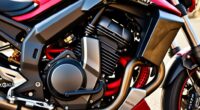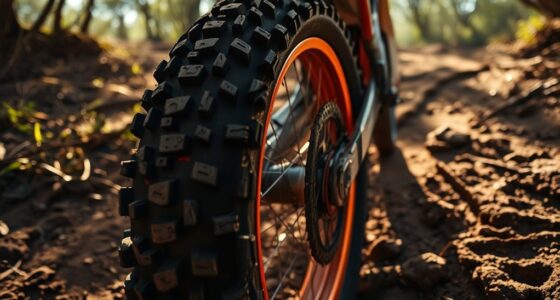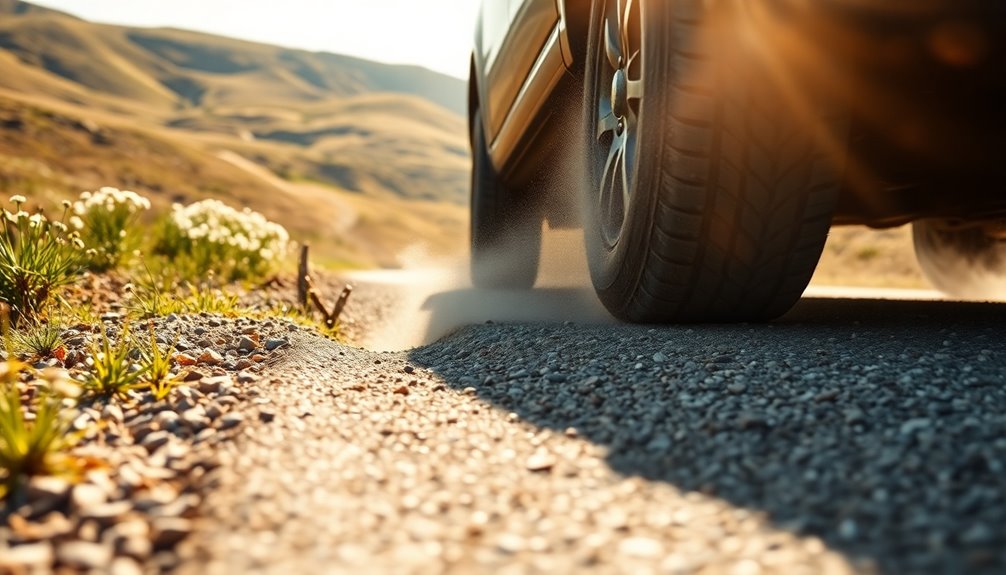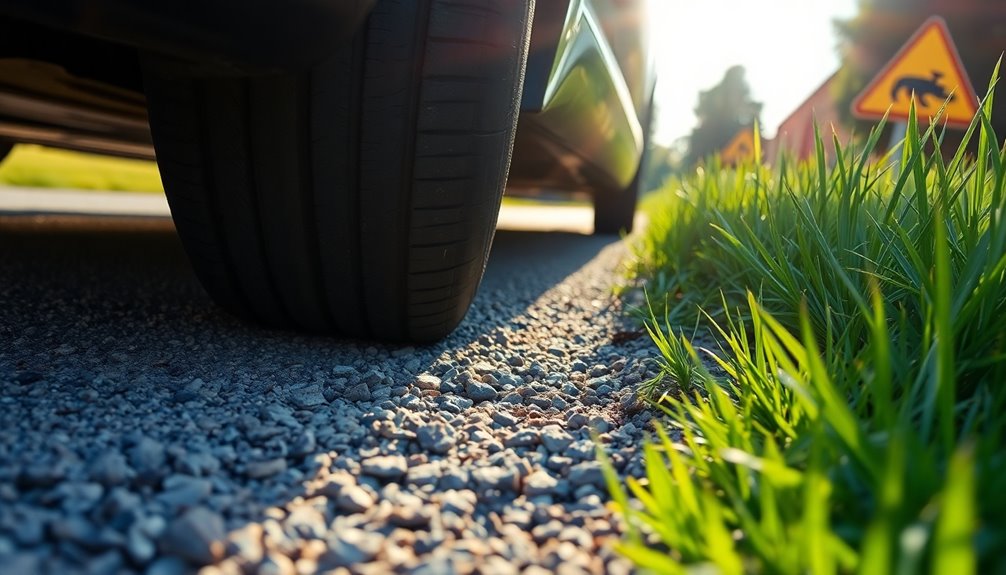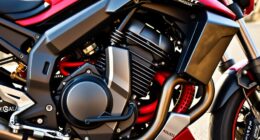Understanding dirt bike traction involves recognizing how rider weight, bike setup, and terrain affect grip. When you apply more downward force—like leaning into turns or adding weight—you increase tire contact and friction, boosting control. Properly adjusting tire pressure and suspension helps maximize grip based on your weight and terrain. Mastering these physics principles improves safety and performance. Keep exploring to discover how fine-tuning these factors can give you an edge on the trail.
Key Takeaways
- Increased downward force from rider weight enhances tire contact and friction, improving traction on dirt surfaces.
- Proper bike setup, including tire pressure and suspension tuning, optimizes tire grip for different terrains.
- Rider body positioning and weight distribution influence tire contact area and traction during turns and rough sections.
- Terrain type dictates the need to adjust riding technique and bike setup for maximum grip and safety.
- Effective throttle control and braking help maintain tire traction and prevent slip in challenging conditions.
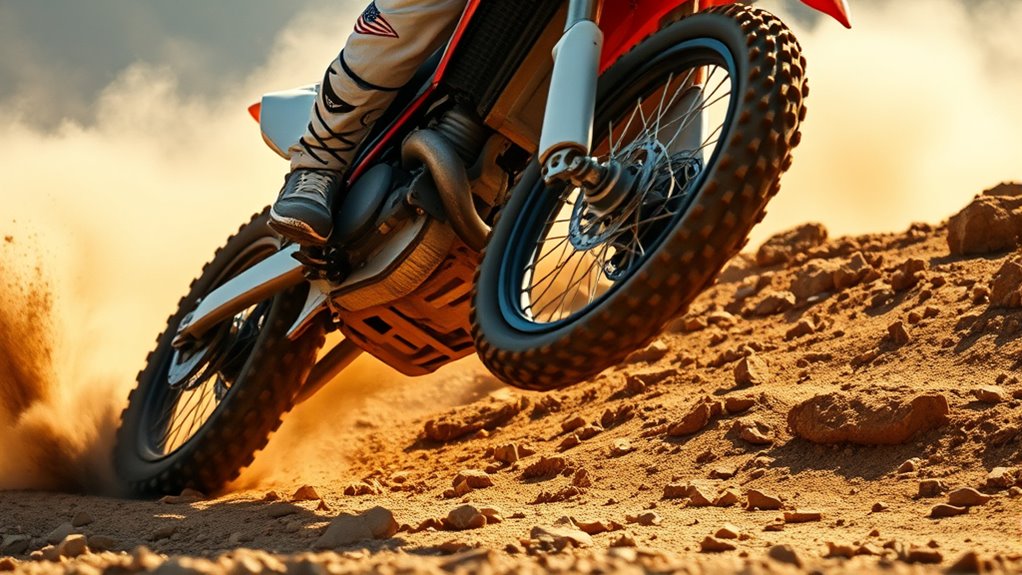
Have you ever wondered why some dirt bike riders seem to glide effortlessly over rough terrain while others struggle for grip? The secret lies in understanding dirt bike traction, especially how tire grip interacts with rider weight. When you’re riding, your bike’s tires are the only contact point with the ground, making their grip essential for control, speed, and safety. Tire grip depends on multiple factors, but rider weight plays a significant role. Heavier riders tend to exert more downward force on the tires, increasing traction because of the added pressure. This extra weight pushes the tire into the dirt, creating more friction and reducing slip. Conversely, lighter riders might need to adjust their technique or tire pressure to achieve similar grip levels, since less force is pressing the tire into the terrain.
Your rider weight influences how the bike’s tires engage with the ground. If you’re heavier, your weight naturally increases tire contact pressure, which can improve grip on loose or uneven surfaces. But too much weight can also cause the tires to sink or deform, especially on soft terrain, which might reduce overall traction. That’s why many experienced riders fine-tune their bike setup—adjusting tire pressure or suspension—to optimize grip based on their weight and riding conditions. Proper tire pressure is vital: if it’s too high, the tire becomes less able to conform to irregularities in the terrain, reducing grip. If it’s too low, the tire can deform excessively, diminishing stability and potentially causing a loss of traction.
Heavier riders can improve grip but risk sinking; fine-tune tire pressure and suspension accordingly.
Your riding style and body positioning also influence tire grip. Leaning into turns or shifting your weight forward or backward helps distribute force more evenly across the tires. When you stay centered or lean into corners, you help maintain consistent tire contact and pressure, maximizing grip. This is especially important when navigating tricky sections, like loose dirt or rocky patches, where maintaining traction can make or break your ride. Additionally, understanding dirt bike traction and how tire grip interacts with terrain can help you choose the best riding strategies for different conditions. Also, consider how your riding technique impacts tire grip: smooth throttle control, controlled braking, and deliberate steering help keep the tires engaged with the terrain, preventing unnecessary slippage.
In essence, understanding how tire grip and rider weight interact allows you to adapt your riding and bike setup to different conditions. Whether you’re leaning into a tight turn or powering through a muddy trail, knowing how to manage these factors gives you the edge to stay connected with the ground. With practice, you’ll learn to read the terrain and adjust your weight and riding style to maximize traction, making your ride smoother, safer, and more controlled.
Frequently Asked Questions
How Does Tire Pressure Affect Dirt Bike Traction?
Lower tire pressure increases your dirt bike’s traction by enlarging the contact patch, helping you grip uneven terrain better. However, too low pressure can cause tire wear and traction loss on hard surfaces. On the other hand, high pressure reduces tire contact, leading to less grip and faster tire wear. Find a balance suited for your riding conditions to maximize traction, minimize tire wear, and avoid traction loss.
Can Rider Weight Influence Traction on Different Terrains?
Yes, your rider technique and bike weight distribution considerably influence traction on different terrains. When you shift your weight appropriately, you improve grip and stability, especially on loose or uneven surfaces. Properly managing your rider weight helps the bike’s tires maintain better contact with the ground, enhancing traction. By adjusting your body position and leaning into turns, you optimize bike weight distribution, giving you better control and reducing the chances of slipping.
How Do Mud and Water Impact Traction Levels?
Mud and water reduce your dirt bike’s traction by decreasing the mud grip and increasing water slippage. When you ride through mud, the grip weakens as the mud clings to your tires, making it harder to maintain control. Water causes your tires to slip more easily, especially on slick surfaces. To improve traction, stay light on your controls, choose tires with good mud and water grip, and adjust your speed accordingly.
What Role Does Suspension Play in Maintaining Traction?
You play a vital role in maintaining traction through your suspension. Proper suspension damping absorbs shocks, keeping your wheel contact consistent with the terrain, which improves grip. Also, maintaining correct wheel alignment ensures your tires stay properly oriented, preventing slipping or uneven wear. When you adjust your suspension and keep your wheel alignment in check, you enhance traction, especially on rough or slippery surfaces, giving you better control and stability.
Are There Specific Tire Treads for Different Dirt Bike Terrains?
Yes, there are specific tire tread patterns for different dirt bike terrains. You should choose terrain-specific tires based on the surface you’ll ride on most often. For muddy conditions, look for tires with deep, aggressive tread patterns that grip well in slick mud. For dry, loose dirt, opt for tires with knobbies that provide better traction. Picking the right terrain-specific tires guarantees ideal grip and control, making your ride safer and more enjoyable.
Conclusion
Think of your dirt bike as a trusted partner, its traction the steady hand guiding you through the wild. When you understand how grip and surface work together, you’re not just riding — you’re dancing with the earth. Every twist of the throttle, every lean, becomes a conversation with nature’s rhythm. Embrace this connection, and you’ll find that riding isn’t just a thrill, but a harmony between you and the trail, like a dance on the dirt.

